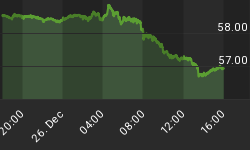LET'S LOOK AT THE S&P 500 DAILY CHART

A majority of all highs and lows are false break patterns. A false break pattern is when the index moves above or below an obvious high or low and fails to "follow through." There was an obvious false break low in March and there is now a false break high in place at the last high. False breaks if valid are always followed by a fast move in the opposite direction that is a fact. They don't always indicate a change in trend and could be just a short term high, but when there are reasons to look for a trend change they can be a very valid indication. We had been looking for a high two weeks ago since that was the normal price and time for a counter trend move if the trend were still down. The only thing missing was a period of distribution and that now appears to have occurred with the false break pattern ending a sideways distribution pattern. Since the move down has been a big two day "follow through" this appears to be a valid indication the uptrend is complete. If this was an intermediate term bear trend rally the index should now follow trending criteria.
That trending criteria, in this circumstance, would call for the index to only rally one to four days until the March low is hit. There have been a few exceptions to the trending criteria where the index has struggled about halfway through the move down but in all cases it has never rallied past 7 days and that would be very, very unusual unless down to or very close to the March low. So if the distribution is complete and therefore not another weak test of the highs and if the trend is now down the rallies should be only one to four days until the March low tested.
LET'S TAKE LOOK AT THE CRUDE OIL WEEKLY CHART

This is an identifiable trend and can be qualified as the exhaustion phase of a blowoff trend. Anytime a market can show three or four ascending trendlines it is in the exhaustion phase of a trend. Since most markets like to exhaust into highs this is not unusual. The previous exhaustion occurred in November 2007 and the final leg was 90 calendar days and was followed by a small sideways consolidation rather than a change in trend. This leg up has now exceeded 90 calendar days and is now 105 days, if we start the count from the last low the date is way out to June 30th and that seem a bit long to continue this exhaustion style of trend. I believe the longest it could go is June 21st but could end any thrust up now. If it corrects back more than 4 trading days the exhaustion will be complete. It will then correct back either ¼ of the last leg up or 1/3 to 3/8 of the last trend up. If you are looking for a top in oil the history of this market is tops take many months to form even when following an exhaustion phase, sometimes even closer to a year. So if the top where in today it would only be vulnerable to 115 before coming back up to form a very large topping pattern or even a consolidation before moving higher. But make no mistake this is an exhaustion phase of this trend and will end very soon. The dollar is looking vulnerable again and the base in T-BONDS is now questionable.
















